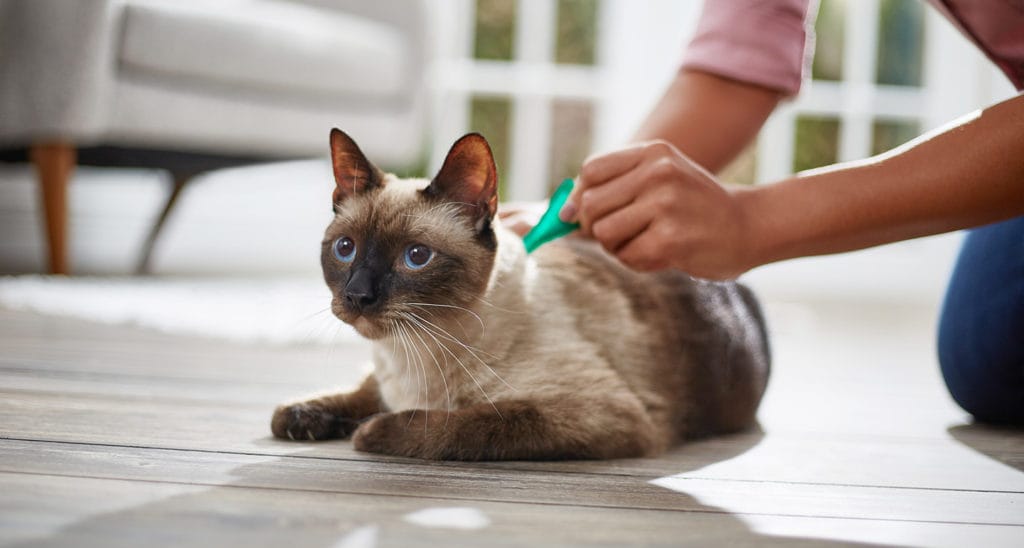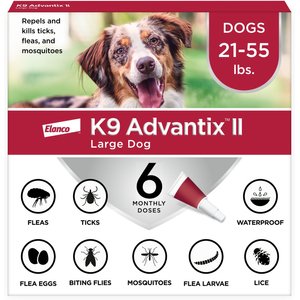Fleas are the worst. They make your pet itch. They leave flea dirt behind. And they can even cause scary diseases. Flea protection is an essential part of pet parenting—and one of the most popular ways to do it is spot-on flea treatment.
But what exactly is this stuff? How does it work, and how do you use it? We’ve got the answers below.
What Are Spot-on Flea Treatments?
Spot-on flea treatments are medicinal liquids that protect your pet from blood-hungry parasites like fleas and ticks, says Dr. Sarah Wooten, DVM. A spot-on treatment comes packaged in individual doses of liquid that can be applied by pouring the medicine onto your pet’s back, between the shoulders. One dose generally keeps a pet safe from fleas and ticks for one month, Dr. Wooten says, but will need to be applied more often if your pet swims or is bathed often.
How to Apply Spot-on Flea Treatments
Spot-on flea treatments are applied directly to nape of your pet’s neck. “I recommend to part the hair so that you can get all the way down to the skin,” says Dr. Angela Crudington, DVM, of Plaza Del Amo Animal Hospital in Torrance, California. No, the back of the neck doesn’t have magic medicine-absorbing powers. The reason for that placement is “so that the pet cannot lick the product,” Dr. Crudington says.
Larger animals, however, may require a larger dose applied to several spots along the back, Dr. Wooten says. Follow the directions on the package, and consult a veterinarian with any questions.
It’s important to make your pet feel relaxed and comfortable during this process. After all, Dr. Wooten says, you don’t want to wrestle or struggle with them during application, turning this monthly routine into a traumatic experience for your both. It will also be easier to apply the treatment properly if your pet is calm and still. Dr. Wooten suggests pairing the application experience with something positive, like a treat or some encouraging words and scratching from you.
After applying, skip the suds. Bathing your pet too soon after treatment can reduce or even eliminate its effectiveness.
“Do not bathe your pet for at least two days after application, so that the product has enough time to absorb appropriately,” Dr. Crudington says.
If you have a multi-pet household, keep treated pets apart for 24 hours while the spot-on treatment absorbs, Dr. Wooten says. Monitor your pet, and keep them from rolling around. Your pet will feel the treatment on their skin, and may want to rub it off, so it’s important to keep a watchful eye on them, she adds.
How Spot-On Flea and Tick Treatments Work
Pets’ skin absorbs the medication, which is then carried through the circulatory system, according to Dr. Wooten. That means any flea or tick that bites your pet will ingest it.
Some spot-on treatments also work to prevent flea eggs from hatching, Dr. Wooten says, while others stop flea larvae and pupae from maturing. Popular among pup parents, K9 Advantix II Flea & Tick Treatment for dogs is formulated to kill all life stages of fleas to prevent reinfestation—and fights against ticks, including deer ticks and American dog ticks, as well as mosquitoes and lice.
You’ll need to make sure you pick the right treatment for the size of your pet, as many of these spot-on products are formulated for pets based on their weight. Frontline Plus for dogs comes in four options: for dogs 5-22 pounds, for dogs 23-44 pounds, for dogs 45-88 pounds and for dogs 89-132 pounds. Very large dogs may require more than one dose to cover their weight. Check with your veterinarian for the appropriate amount of treatment to give your dog.
Fleas on cats can be just as aggressive. Frontline Plus for cats is formulated to kill both adult fleas and ticks, and next generation flea eggs and larvae. It works for 30 days on cats.
Spot-on Flea Treatment Cautions
While spot-on treatments are effective and safe if used correctly, they can cause side effects if not used properly, Dr. Wooten says. Consult your veterinarian prior to applying spot-on flea and tick treatments, and read accompanying literature to make sure you’re using the product correctly and on the correct type of pet.
“Seek veterinary advice prior to application or use spot-on treatments, especially for pets who have seizures or skin sensitivities, as some treatments can cause these conditions to worsen,” Crudington says.
Share:













